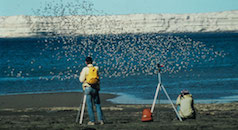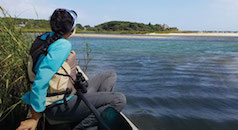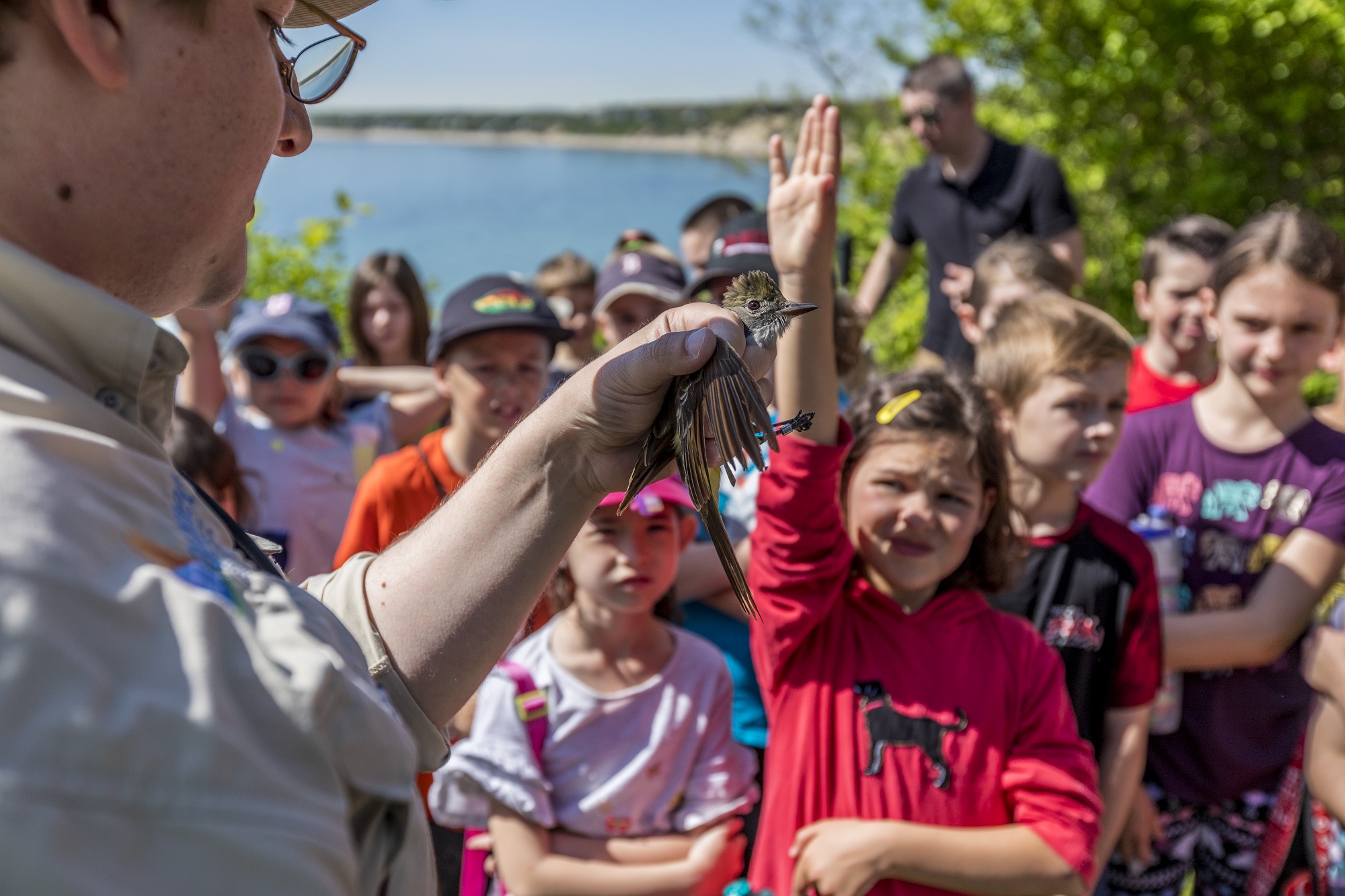Search Results

Arctic Nesting Whimbrels – 2023
The drone of the Cessna 185’s motor had just faded into the distance when we heard the first Whimbrel calling as it flew overhead. It is difficult to convey the sense of relief and excitement from hearing that single call. Kirsti Carr and I had just been dropped as the first on the ground at a new field site on the Jago River in the Arctic National Wildlife Refuge, while the pilot went back to pick up the rest of the team, three biologists working for the US Fish and Wildlife Service (USFWS). Kirsti works for Point Blue Conservation Science, but had worked with Manomet and the USFWS in previous summers conducting arctic shorebird research. Dr. Sadie Ulman, Robyn Thomas,...
Arctic Shorebird Research
In recent decades, shorebird populations have plummeted. Without effective and immediate action, some species could disappear entirely in the coming decades. Scientists know that populations are falling precipitously, but they don’t know exactly why. Through our Arctic shorebird research, Manomet researchers hope to unlock some of the mysteries of these dramatic shorebird population declines.
NO BOUNDARIES: Our Flagship Species
Lindsay the Whimbrel: August 5, 2021, Update
Lindsay the Whimbrel is on the move again! Lindsay is one of six Whimbrels tagged earlier this summer in the Katakturuk River Valley in the Arctic National Wildlife Refuge. These tags allow us to study local movement patterns and long-distance migration pathways and stopover sites. After making the 3-day crossing from Alaska to California, Lindsay stopped in San Francisco Bay for a week to rest and refuel. Then, on the evening of August 2nd, she took off heading south again along the coast. She stopped briefly in San Diego harbor after flying for about 12 hours, then headed out again on the evening of August 3rd, crossing into Mexico and arriving a few hours later on the expansive mudflats of...
The State of the Birds on Cape Cod
The State of the Birds on Cape Cod Shorebirds and saltmarsh sparrows are among those at a tipping point By William von Herff Apr 2, 2025 WELLFLEET — A new report on research by leading bird conservation scientists, published by Cornell University, confirms that North American bird populations are continuing a steep decline. The North American Bird Conservation Initiative’s State of the Birds 2025 report, released on March 13, reinforces the conclusions of a 2019 study in Science that found there are 3 billion fewer North American birds than there were in 1970. The NABCI report outlines a list of “tipping point” species whose populations have declined by 50 percent since 1970 and includes shorebirds that feed on Outer Cape Cod before their long...
American Oystercatcher Population Rebounds 45% Through Conservation: A decade of science-driven efforts helped restore this vital shorebird
A decade of science-driven efforts helped restore this vital shorebird. Shorebird populations across the Americas have declined by nearly 50% over the past four decades, facing increasing threats from habitat loss, climate change, and human disturbances. Against these odds, the American Oystercatcher has made a stunning comeback, with populations rebounding by 45% since 2008. The recovery is credited to a collaborative, science-based conservation initiative led by Manomet Conservation Sciences, in partnership with the National Fish and Wildlife Foundation and the U.S. Fish and Wildlife Service. The American Oystercatcher, a striking coastal bird known for its bright red-orange beak and distinctive yellow-rimmed eyes, plays a vital role in salt marsh and barrier beach ecosystems. By 2008, its numbers had dropped to just 10,000 birds....
Flat Moonrise
This past Spring, Manomet supporters entered names into our Whimbrel naming contest. Shortly after, Dr. Shiloh Schulte, Senior Shorebird Specialist, tagged a Whimbrel in Alaska (1st picture), and gave her the winning name—Moonrise! The name Moonrise refers to the genus of the Whimbrel, Numenius, which means "new moon" or "young moon." Moonrise left her nesting territory in the Arctic National Wildlife Refuge on July 10, 2023, arriving on the shore of Hudson Bay on July 16. She stayed there resting and refueling until August 2, when she made a 3-day flight to Georgia. She stayed on the coast of Georgia until September 9, just before she left for the Atlantic crossing to South America. This spring, Whimbrels will leave their...
Water for Shorebirds: A Flowing Collaboration on Texas Coast
Because of its proximity to the Gulf of Mexico, Chambers County, on the Upper Texas Coast, plays host to large quantities of migrating songbirds, waterfowl, and shorebirds each spring and fall. Whimbrel (Numenius phaeopus) is a species of shorebird that utilizes this area for northbound staging as they make the great trek between their wintering grounds in South America and their breeding grounds in the arctic. Manomet’s scientists began studying Whimbrel’s use of this area in 2021 with GPS tracking devices, and preliminary analysis of this movement data revealed that 96% of this species’ daytime locations were in fields related to rice production. What makes a rice field so attractive to a Whimbrel? Rice fields can act as a surrogate...
The Small Sit: Migratory strategies of Whimbrel nesting in the Arctic National Wildlife Refuge
Join The Small Sit, Manomet's virtual science series, each month as we learn about the wonders of why birds migrate, the importance of river herring in coastal food webs, and so much more! On December 7th, step into the Arctic National Wildlife Refuge and get into the mind of a Whimbrel to learn about their migratory strategies during nesting season with Manomet's Senior Shorebird Scientist, Shiloh Schulte. This program is free, but registration is required. Whimbrels are representatives of the most imperiled group of shorebirds, curlews and godwits. The population of Whimbrels that migrate along the Western Atlantic is in sharp decline, and the status of the Pacific Coast population is uncertain. Previous tracking studies in interior and North-central Alaska...
New data from satellite transmitters reveals migratory routes of shorebirds in decline
This spring and summer, Manomet scientists and partners tagged over 30 Whimbrels with state-of-the-art GPS trackers in the southeastern U.S. and Arctic. Here’s where those birds are now. By Shiloh Schulte In late May 2022, a team from Manomet and the U.S. Fish and Wildlife Service returned to the Arctic National Wildlife Refuge to continue our collaborative work studying Arctic nesting shorebirds. This year, we worked on several research projects including coastal plain shorebird surveys, a study of shorebird nest survival, remote audio monitoring of nesting birds, and a multi-year tracking study of nesting Whimbrel (Numenius phaeopus). This is difficult work, and only possible thanks to consistent support from Manomet’s individual donors, as well as the National Fish and Wildlife...



